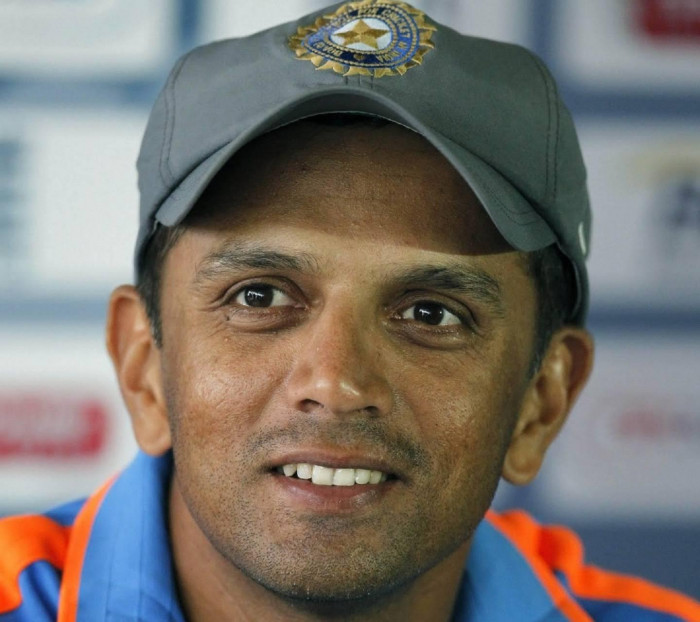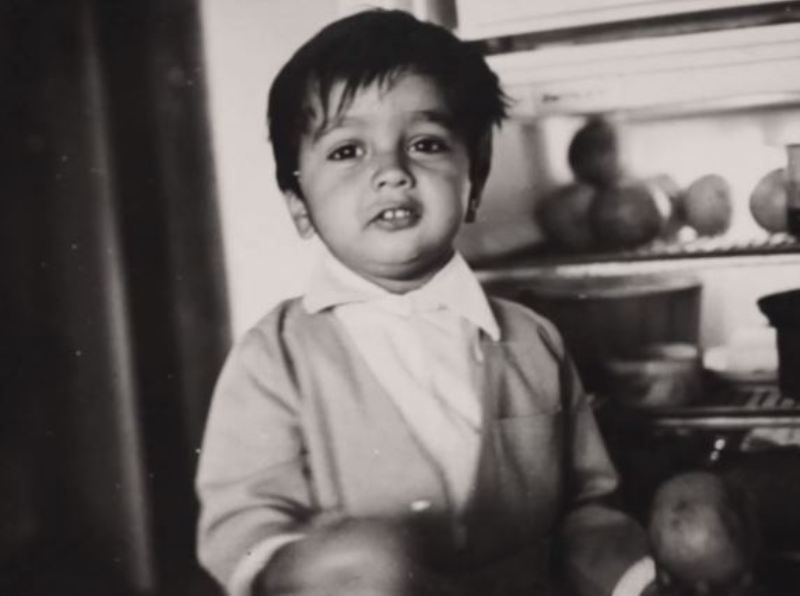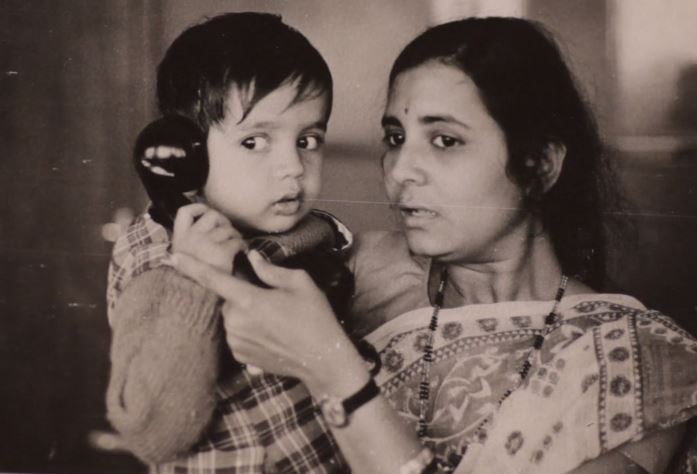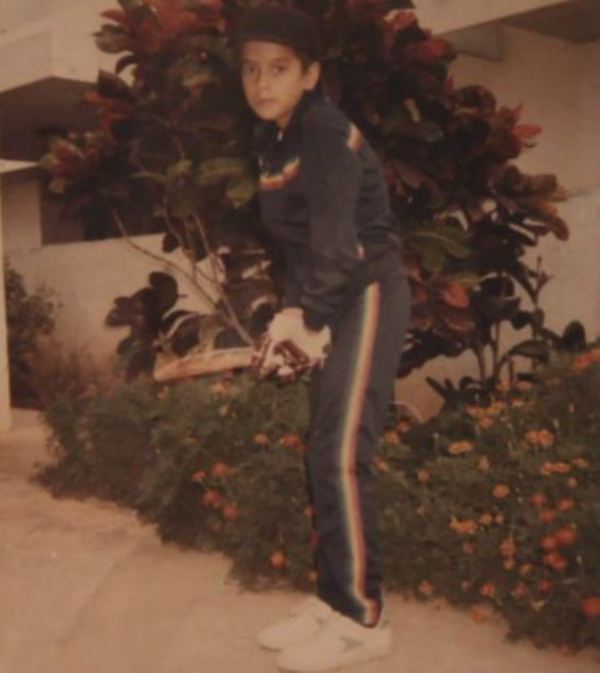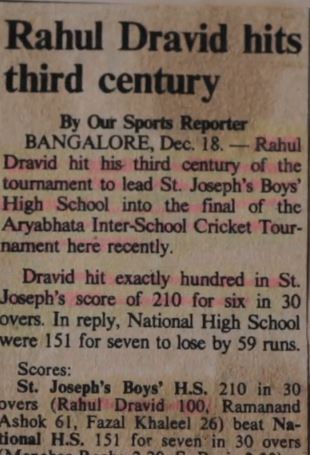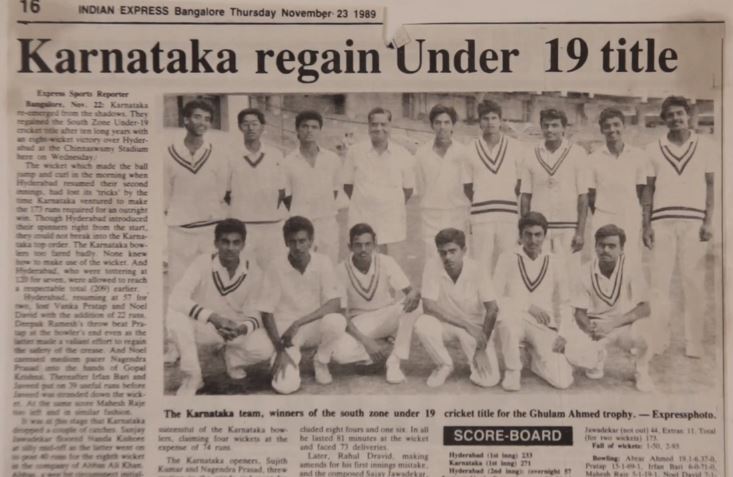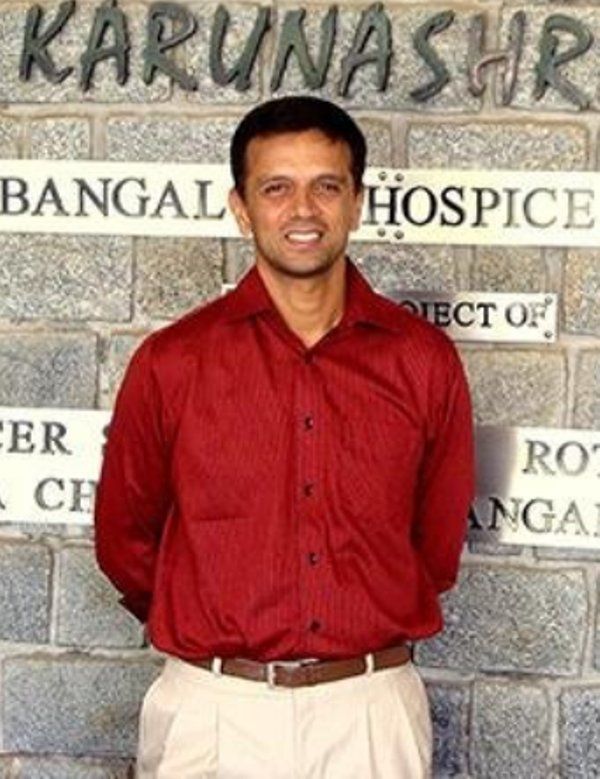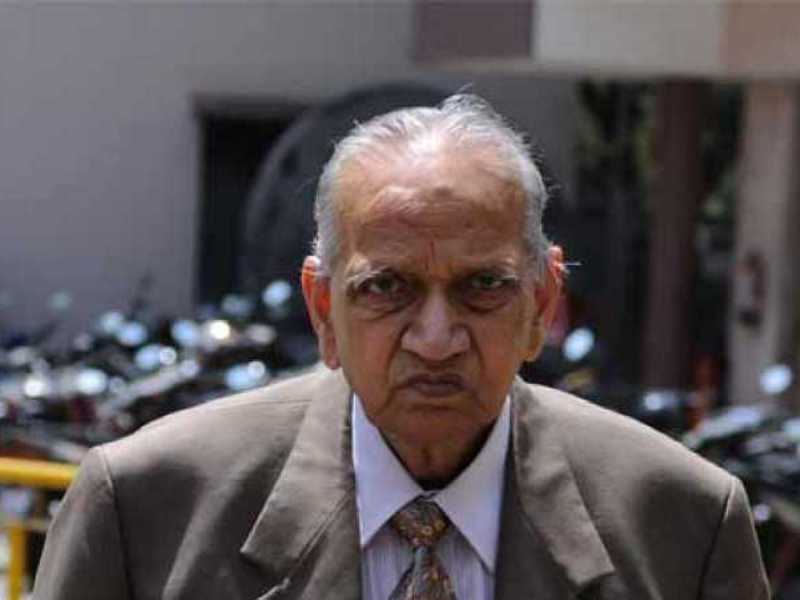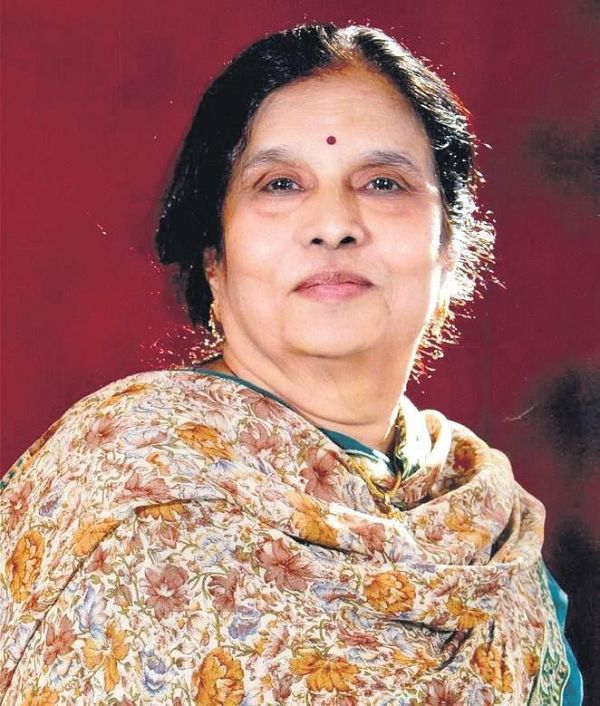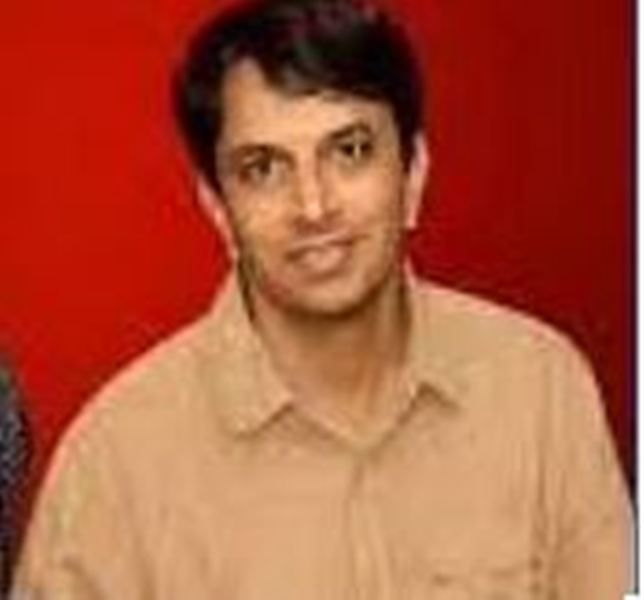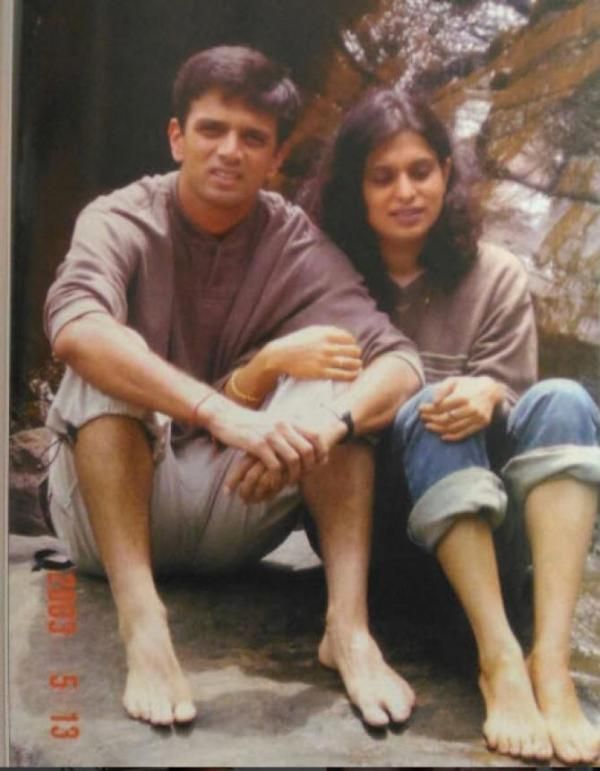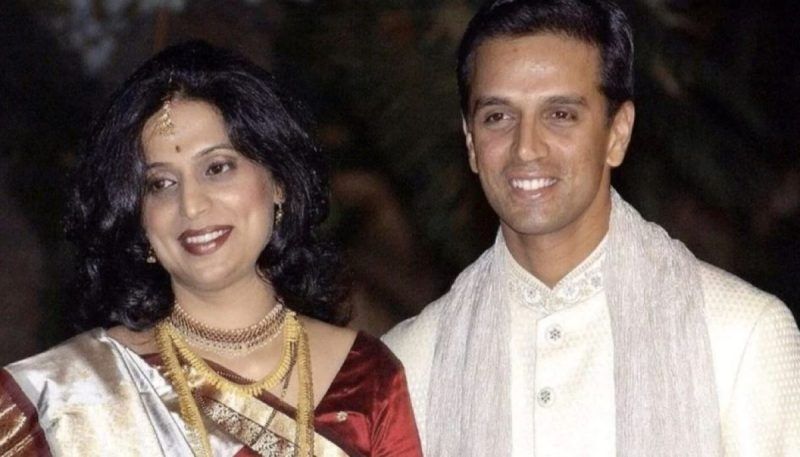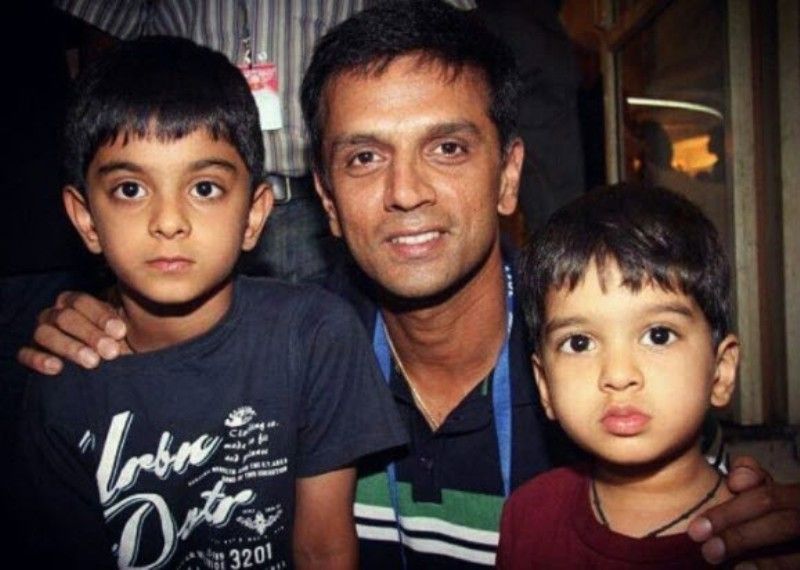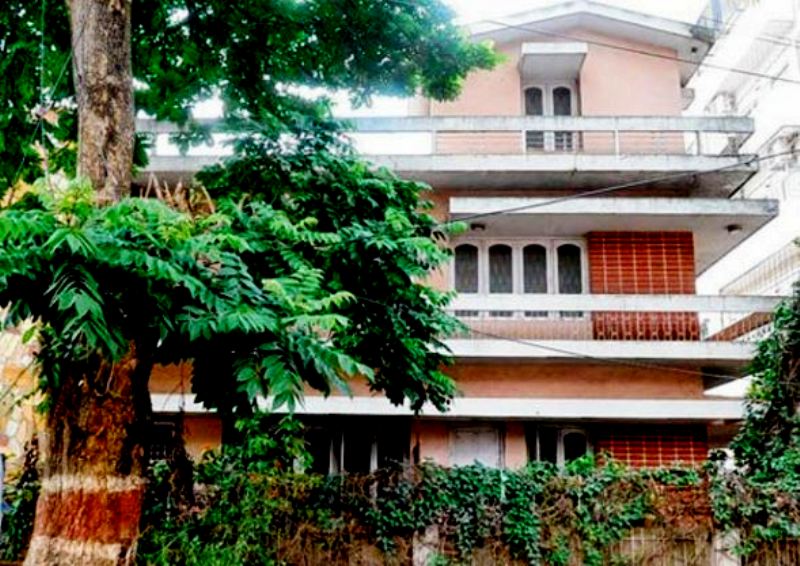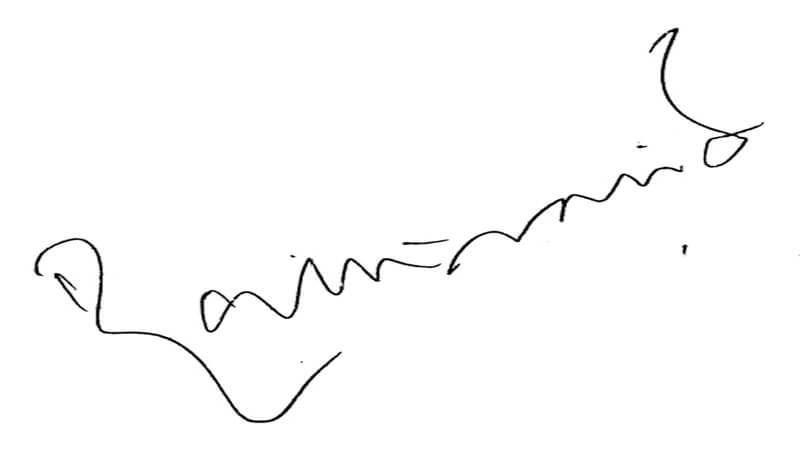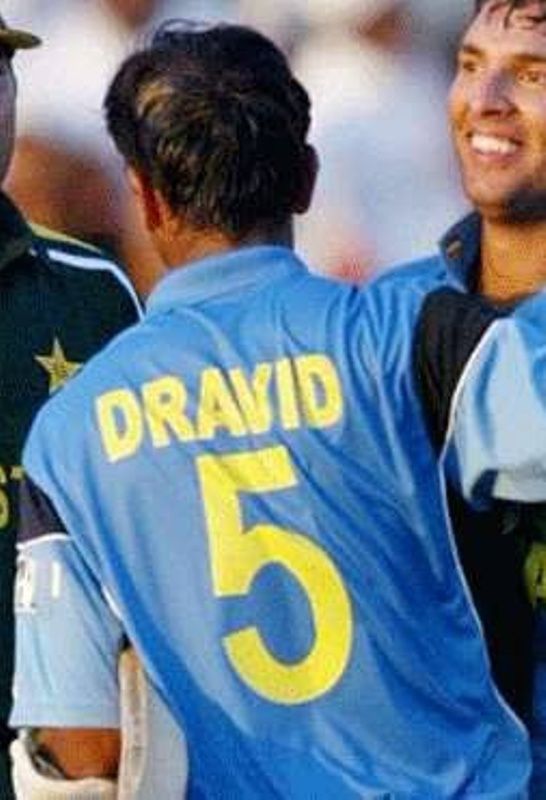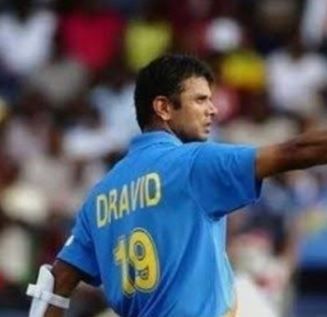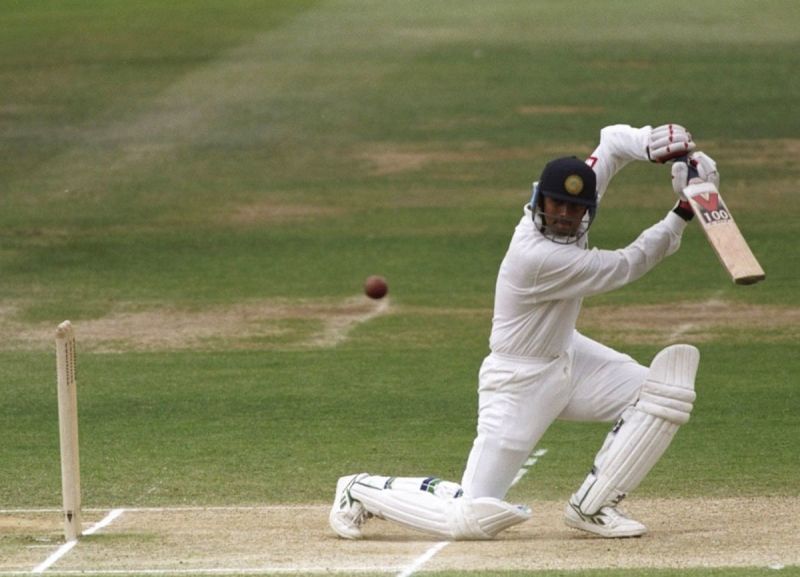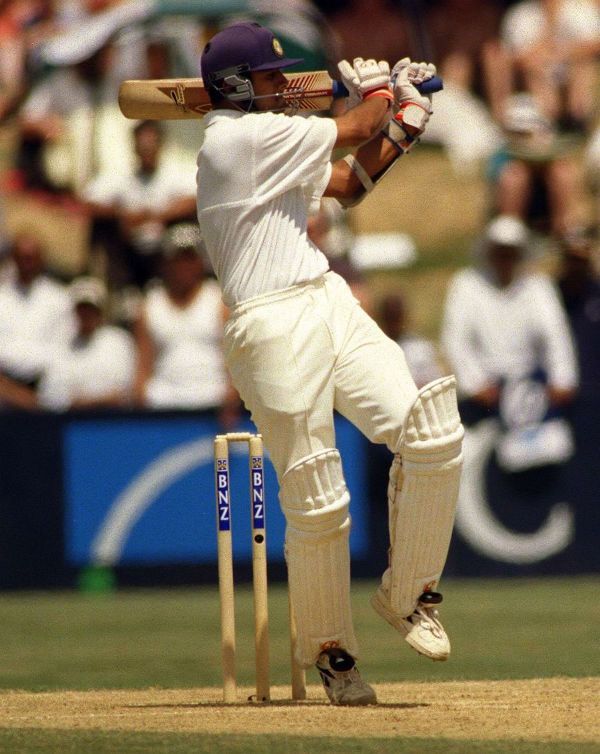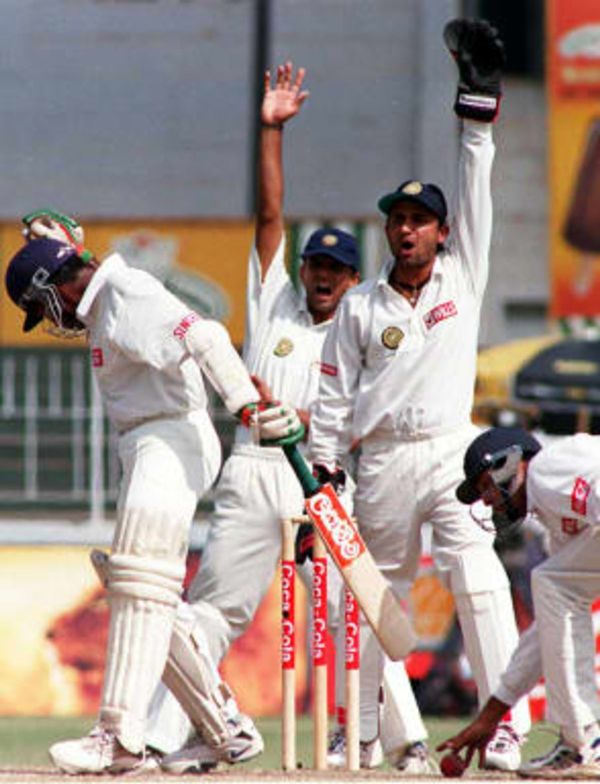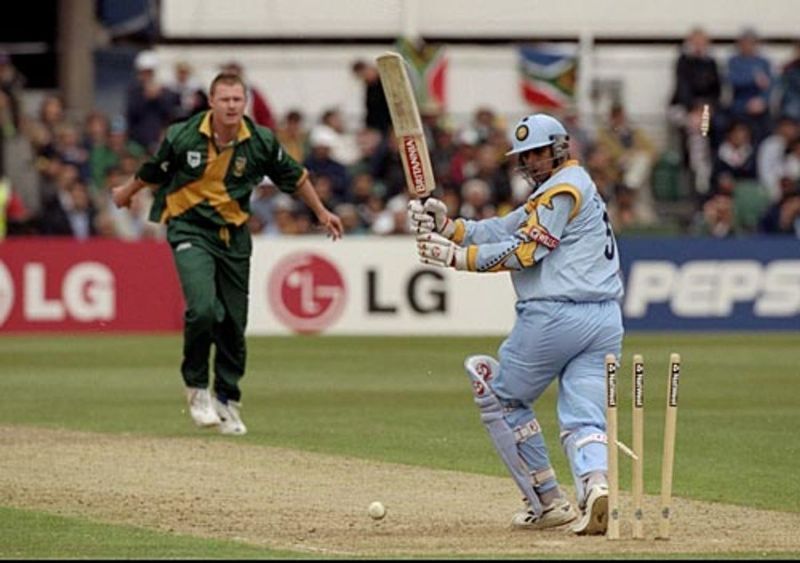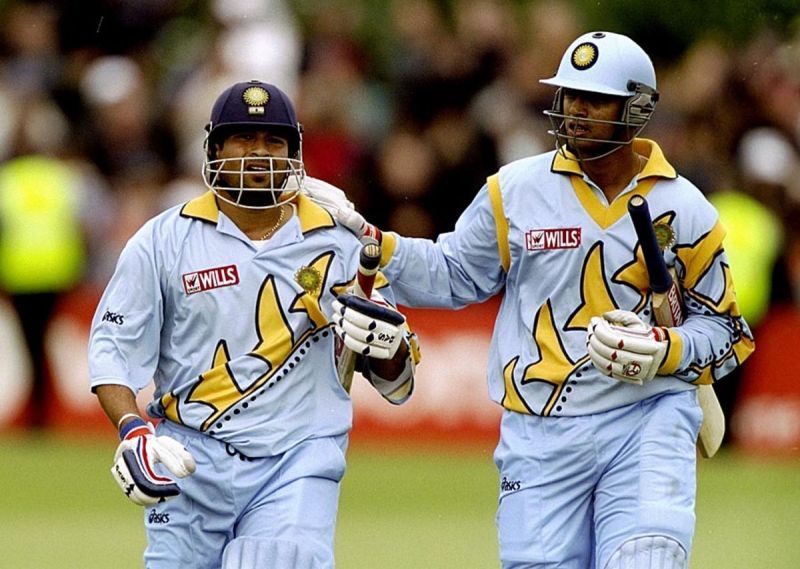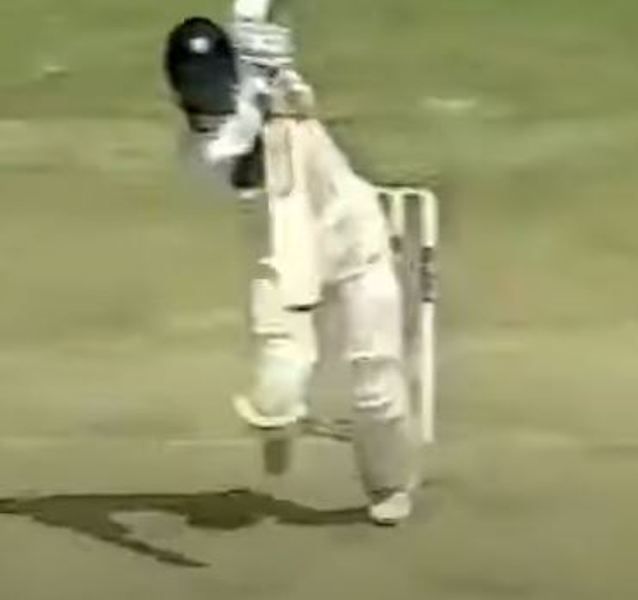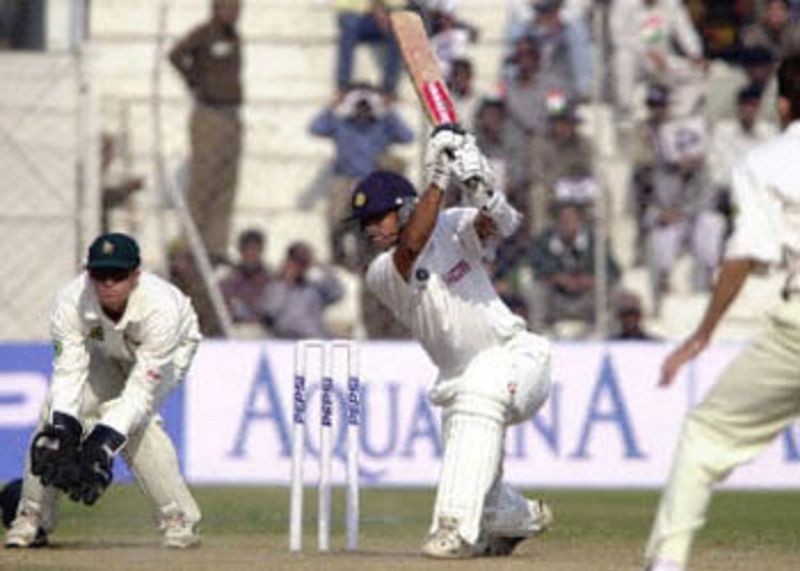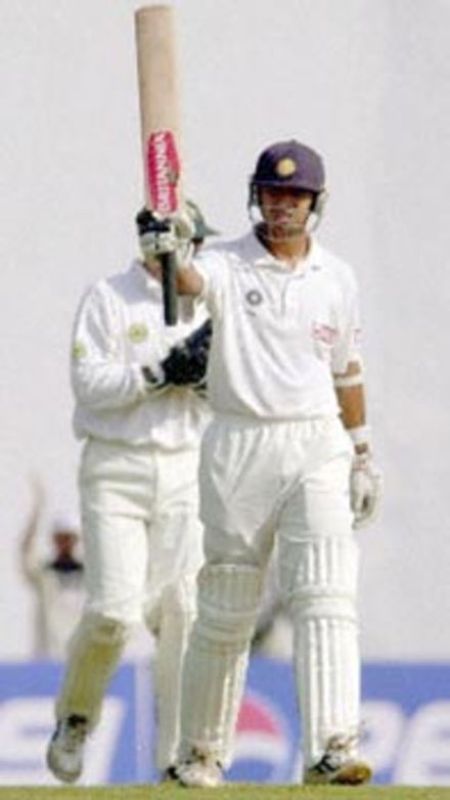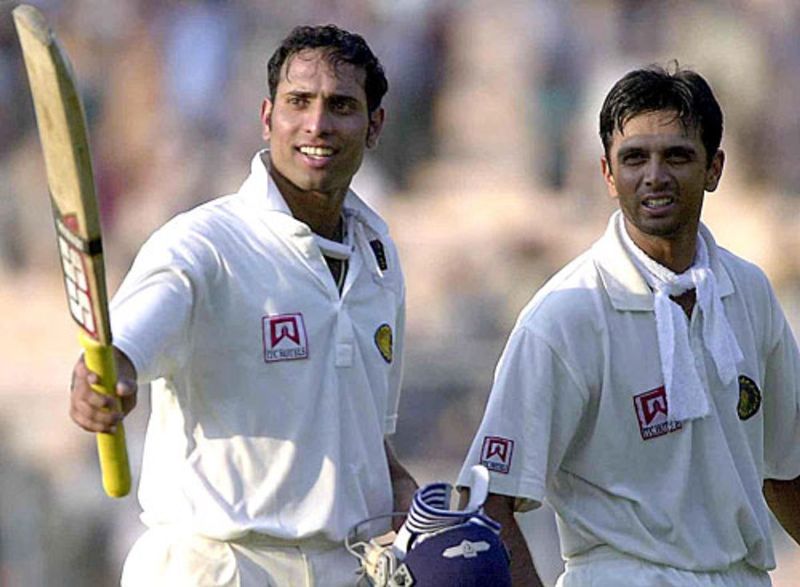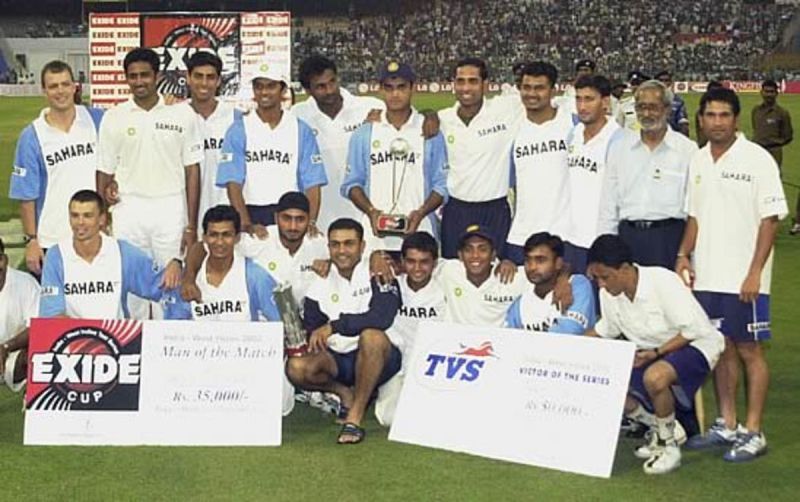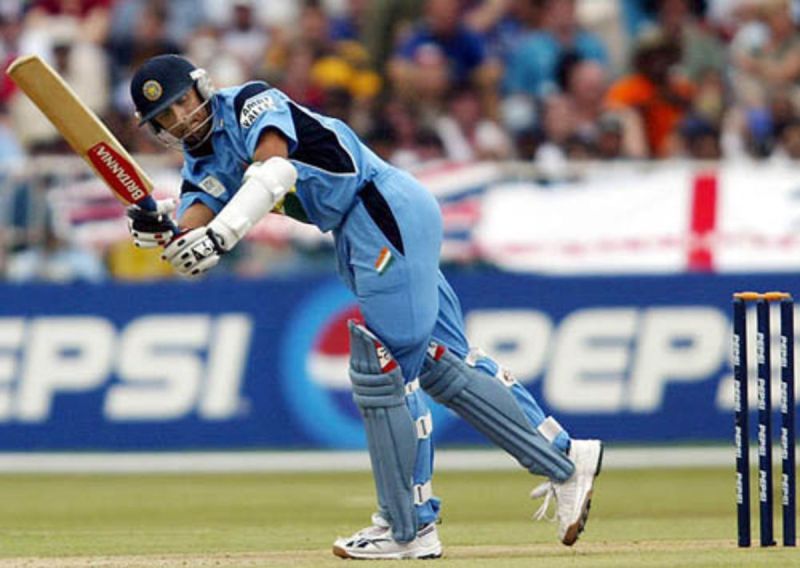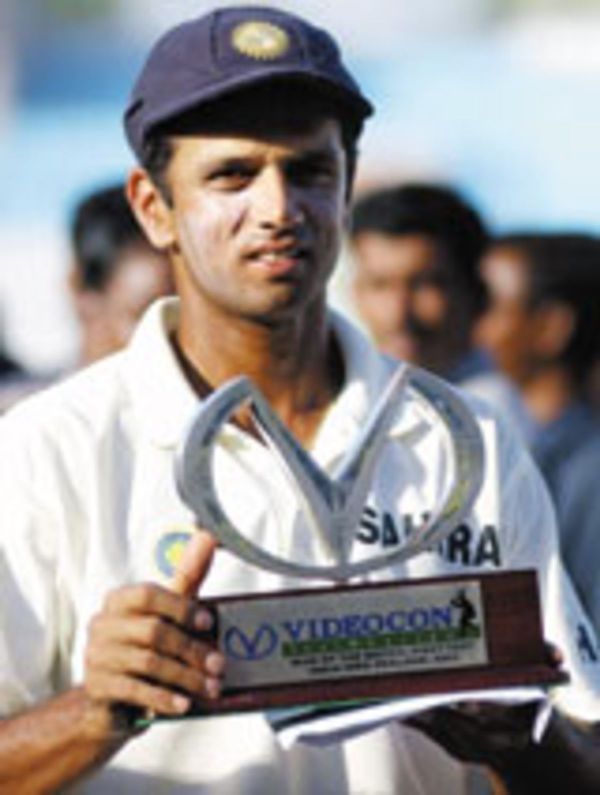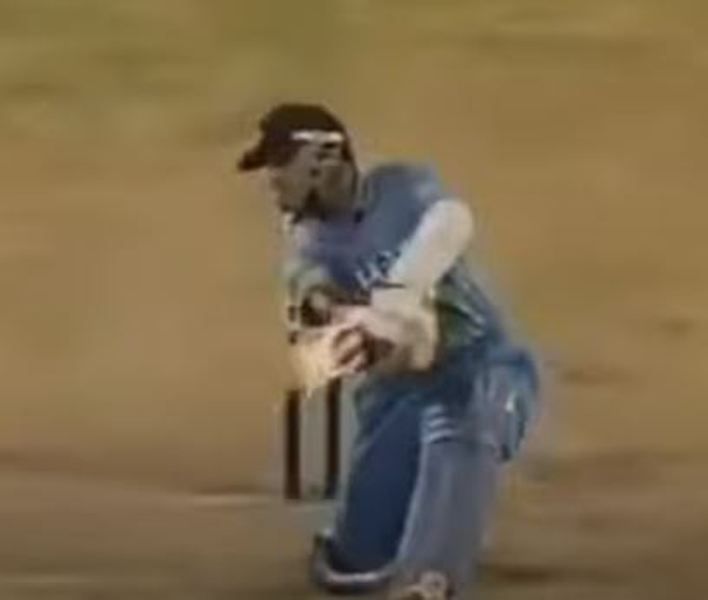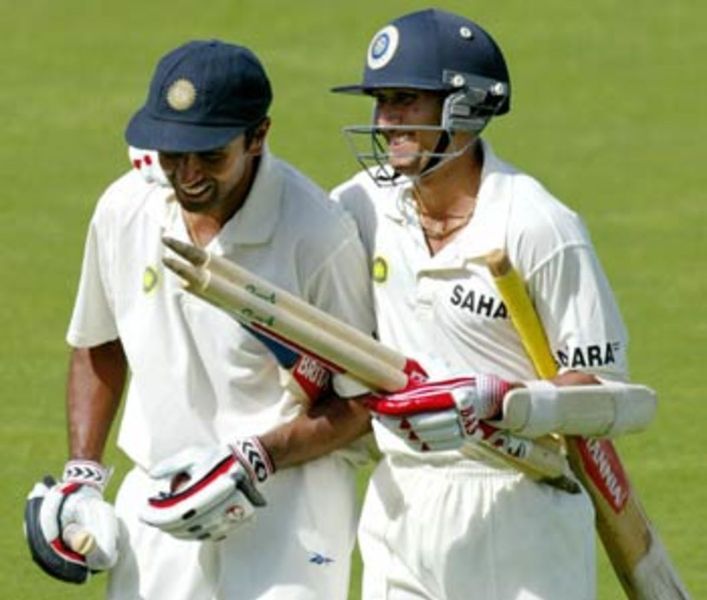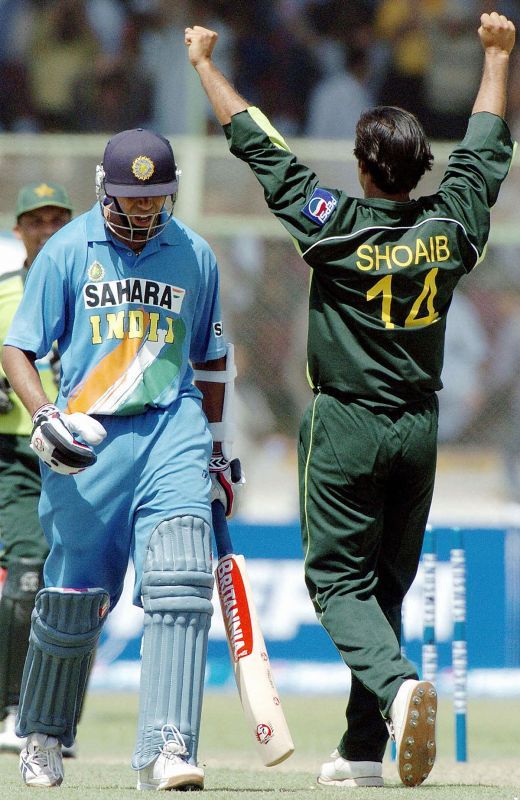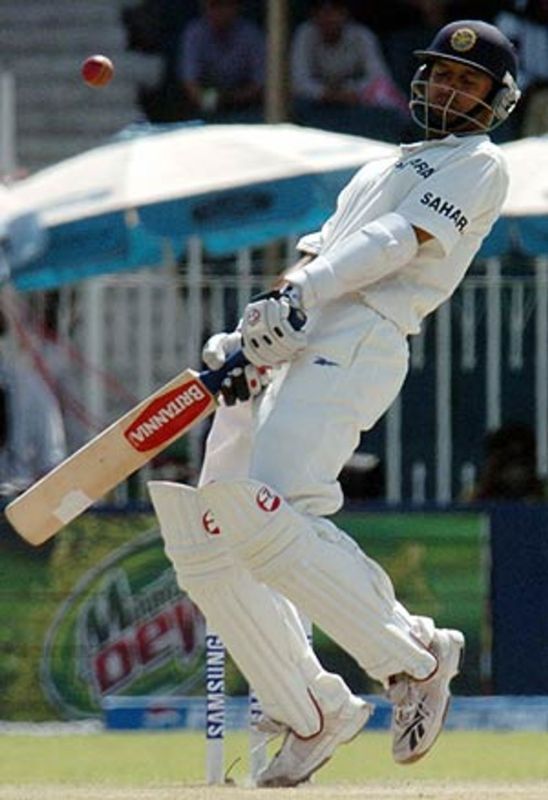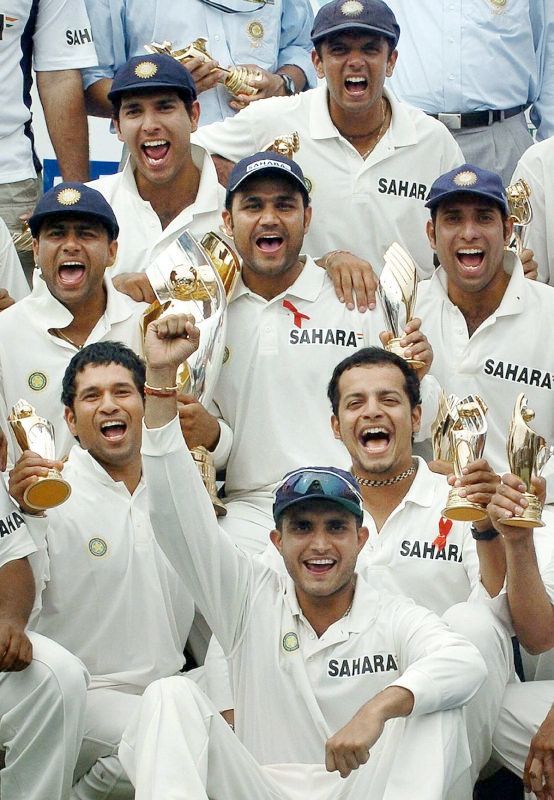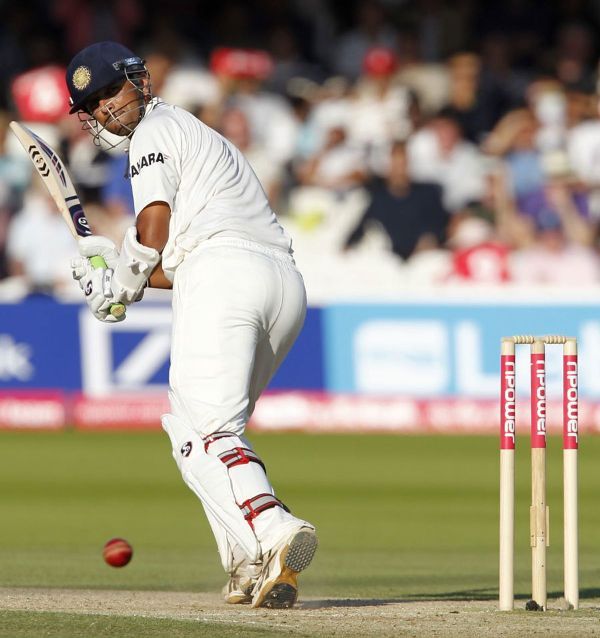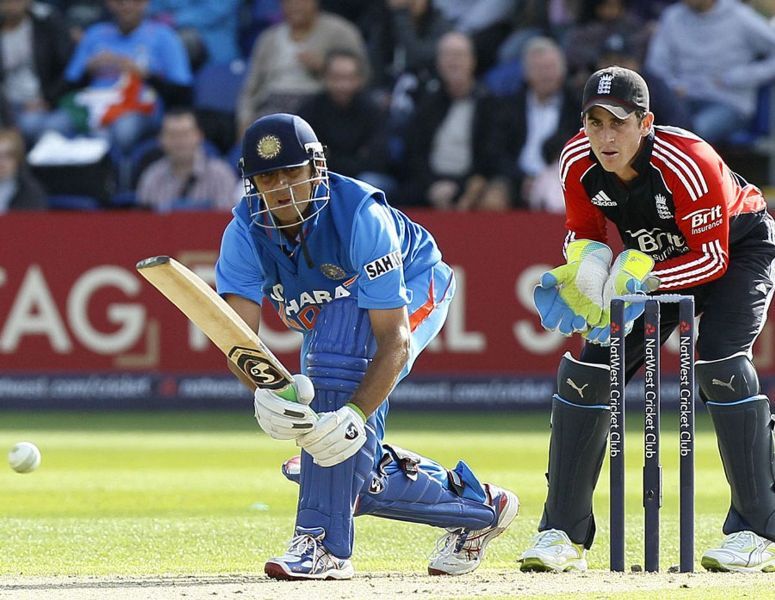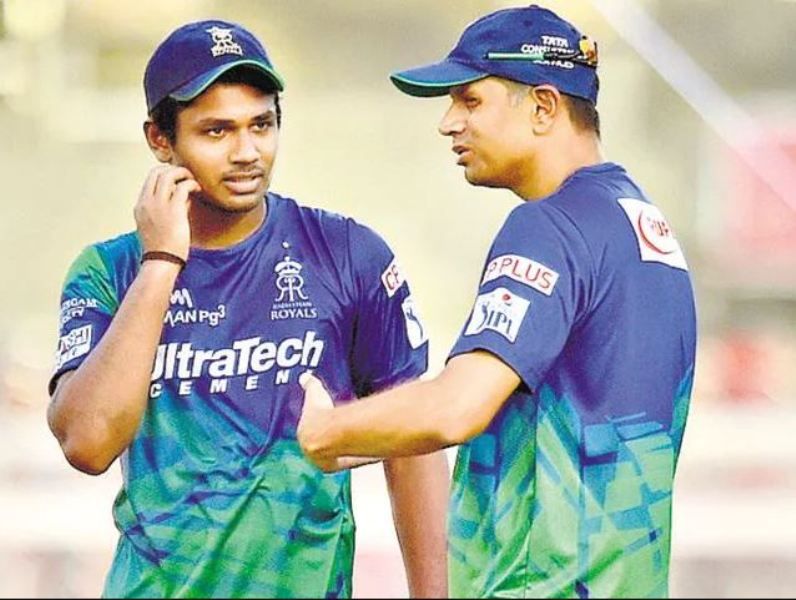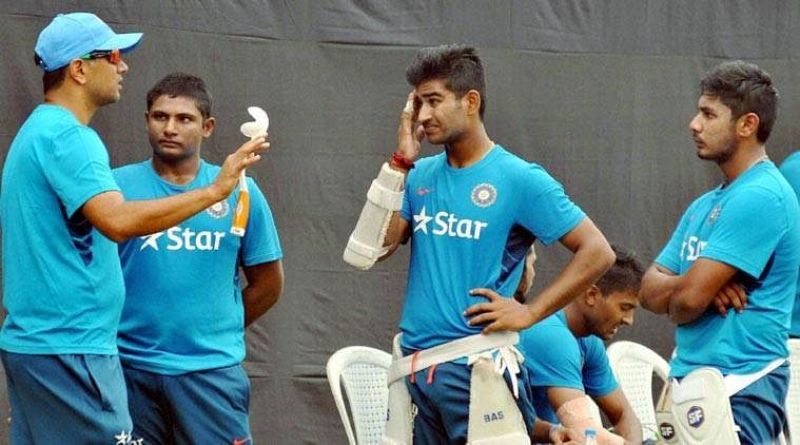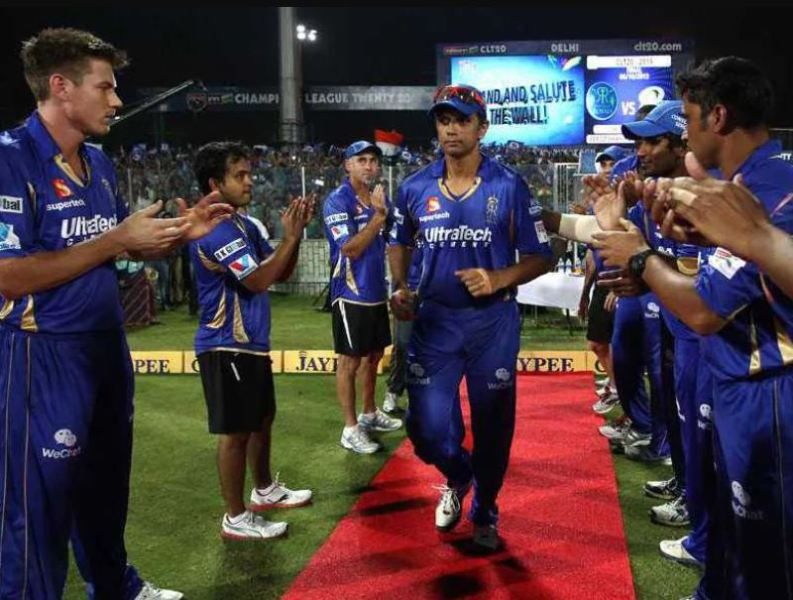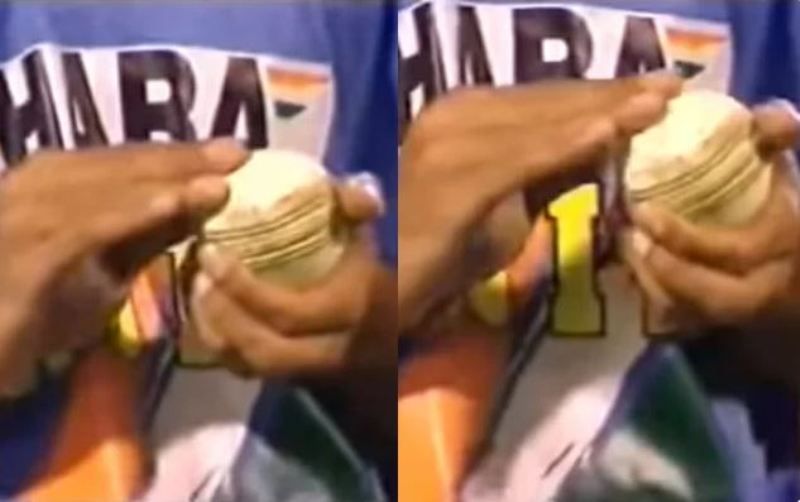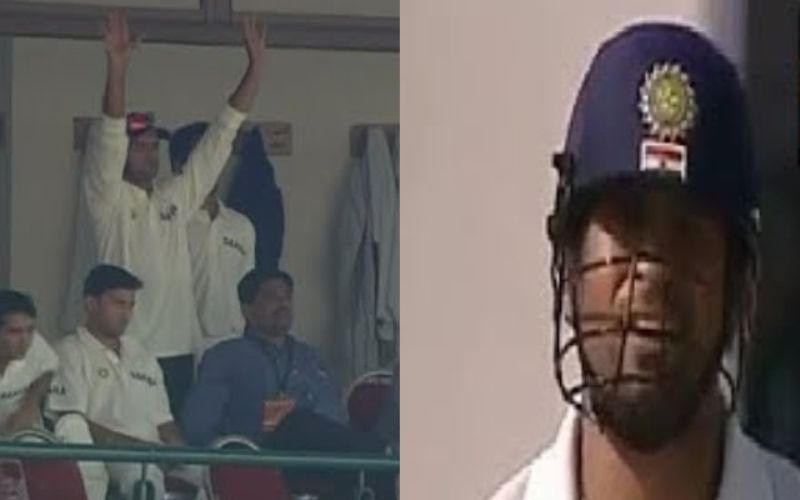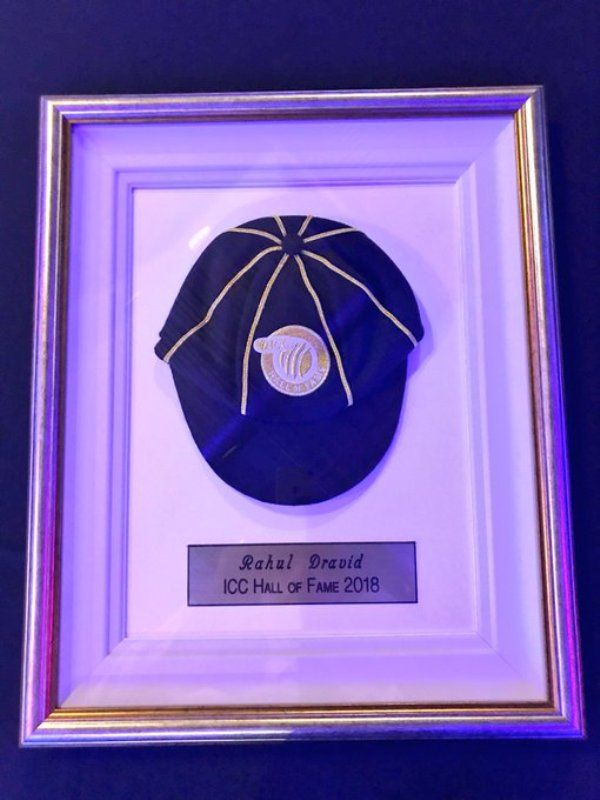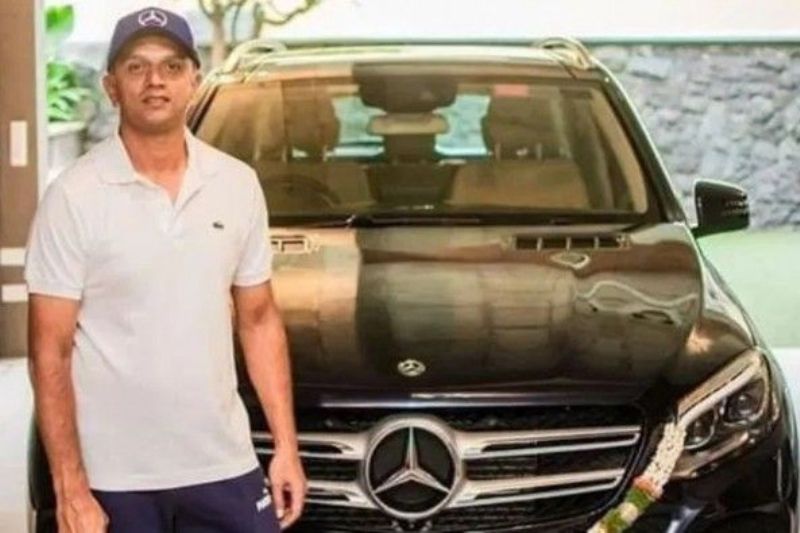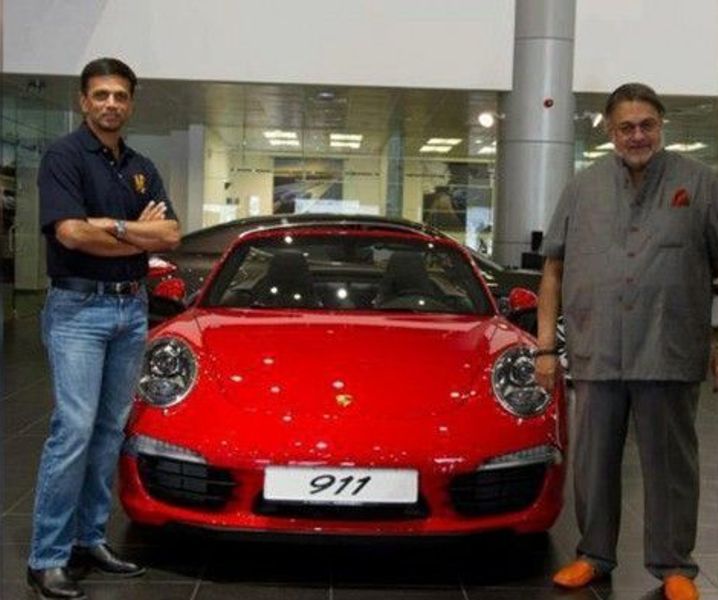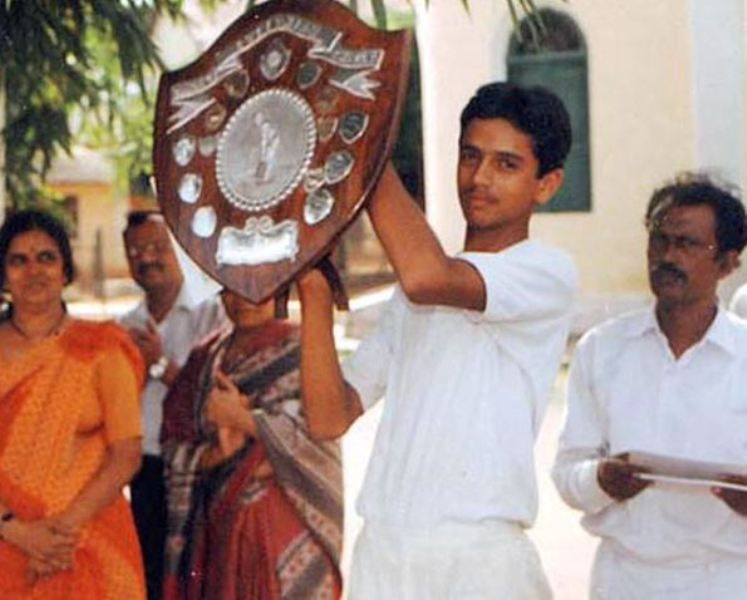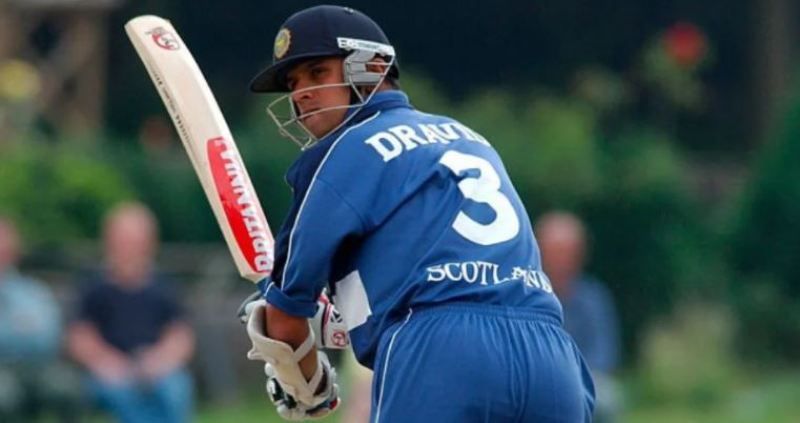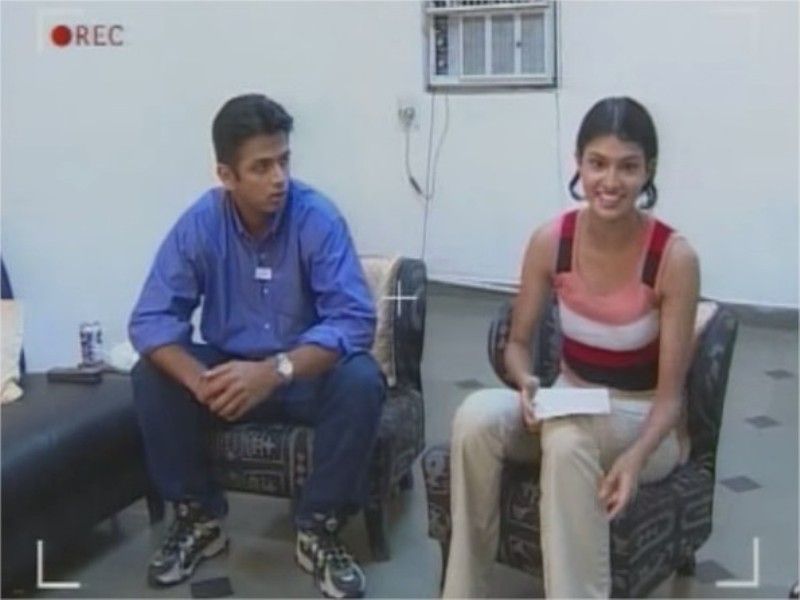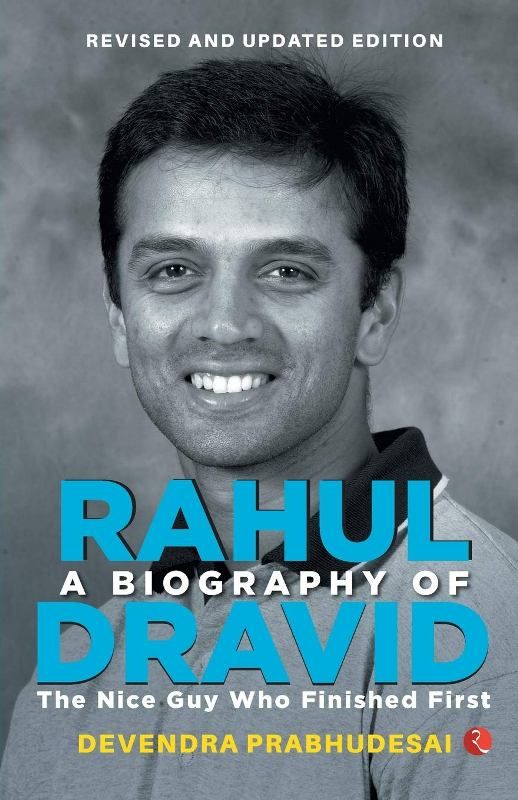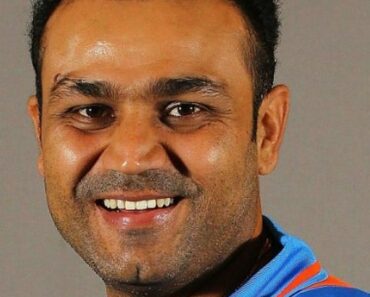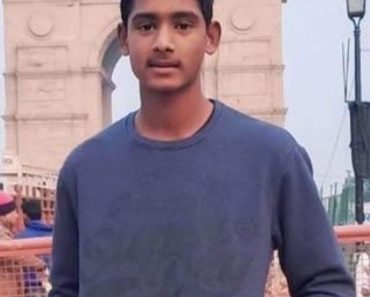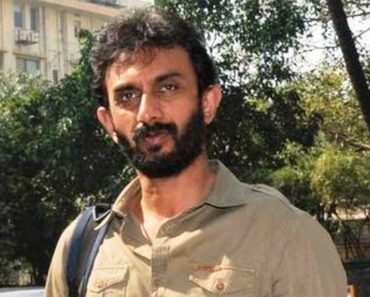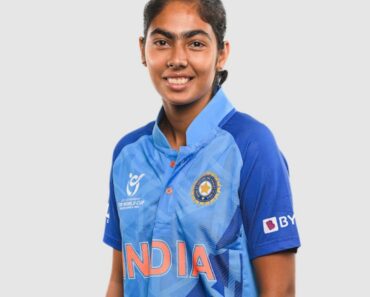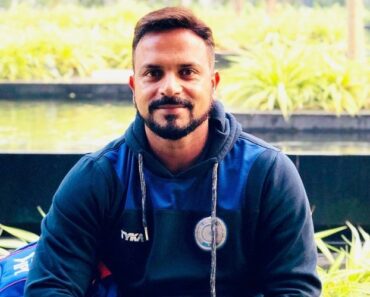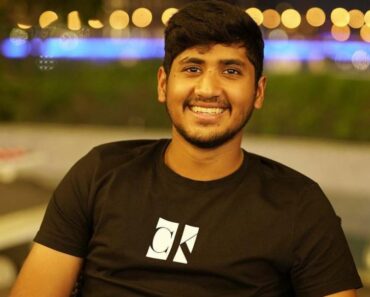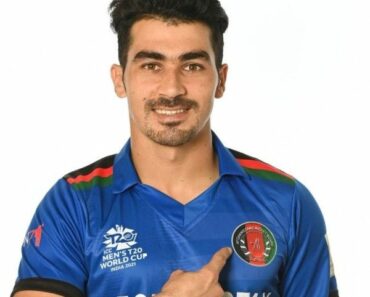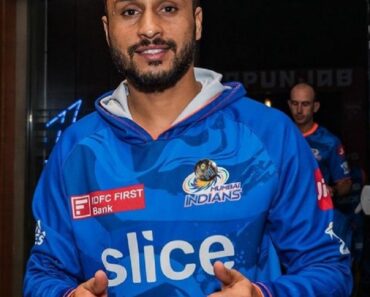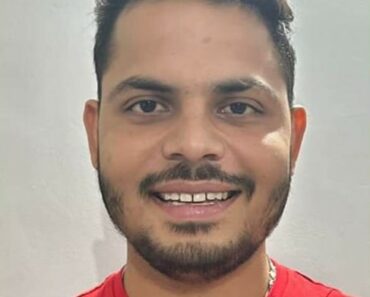Rahul Dravid is a former Indian cricketer widely known as one of the finest batters in cricket history. He was known for his classic batting style who can adapt to any conditions when required. His focus was mainly on playing with a straight bat than with a cross bat. He played international cricket from 1996 to 2012.
Contents
Wiki/Biography
Rahul Dravid was born on Thursday, 11 January 1973 (age 51 years; as of 2024) in Indore, Madhya Pradesh.
His zodiac sign is Capricorn. He completed his schooling at the St. Joseph’s Boys High School, Bangalore (now Bengaluru). Then he took admission to St. Joseph’s College of Commerce, Bangalore University, Bangalore where he has done his Bachelor of Commerce. Further, as he got enrolled in St Joseph’s College of Business Administration, Bangalore for MBA, he got the call from an Indian team to play international cricket. His father was a big fan of cricket so he would take Rahul Dravid to cricket stadiums to watch the match. As a young fan, he liked to play various sports. He took part in high jump and distance running. He started playing cricket at the age of 12 in his school. In an interview, he revealed that his mother made chutney sandwiches for the whole team and his teammates were happy to have him with them just because of that sandwiches.
He then played for his college team with the boys four years older than him. Later, he represented Karnataka at junior levels. He was first spotted by coach Keki Tarapore while he was at summer camp in the Chinnaswamy Stadium (Bangalore).
Physical Appearance
Height (approx.): 5′ 11″
Weight (approx.): 75 kg
Hair Colour: Natural Black
Eye Colour: Dark Brown
Body Measurements (approx.): Chest: 41 Inches, Waist: 34 Inches, Biceps: 13 Inches
Family
Rahul Dravid belongs to a Marathi Brahmin family. [1]The Times of India
Parents & Siblings
His father’s name is Sharad Dravid who worked for the company that makes jams and preserves.
His mother’s name is Pushpa Dravid who was a professor of architecture at the University Visvesvaraya College of Engineering (UVCE), Bangalore.
Rahul Dravid has a younger brother whose name is Vijay Dravid.
Wife & Children
Rahul Dravid is married to Vijeta Pendharkar on 4 May 2003. Vijay Pendharkar is a surgeon by profession. Rahul Dravid’s family knows Vijeta’s family since the time they came to Bengaluru in 1971. Since Vijeta is basically from Nagpur so Rahul Dravid always use to meet her whenever he came to Nagpur.
Both families very soon realized that their children love each other so they took no time to fix their marriage.
The couple is blessed with two sons whose names are Samit Dravid and Anvay Dravid.
Address
Rahul Dravid resides in Indira Nagar, Bengaluru.
Signature/Autograph
Career
International Debut
Test
He made his Test debut on 20 June 1996 against England at Lord’s Cricket Ground.
ODI
He made his ODI debut on 3 April 1996 against Sri Lanka in Singapore.
T20I
He played his only T20I match on 31 August 2011 against England at Manchester.
Last Match
Test
He played his last Test match on 24 January 2012 against Australia at Adelaide.
ODI
He played his last ODI match on 16 September 2011 against England at Cardiff.
Jersey Numbers
Records
- Most time spent at a crease in international cricket (735 hours and 52 minutes) [2]India Today
- Most balls faced in Test cricket (31258 balls) [3]The Statesman
- Most consecutive innings without a duck in international cricket (173) [6]Crictracker.com
- First Indian captain to win a Test match on South African soil in 2006 [8]Circle of Cricket
- Only Indian batter to score four consecutive hundreds in Test cricket [9]Circle of Cricket
- Most number of hundred runs partnerships in Test cricket (88) [10]Circle of Cricket
- The second most runs by a batter away from home in Test cricket after Sachin Tendulkar (8705). [11]Circle of Cricket
- Longest time spent at a crease by a Test cricketer (736 hours) [12]CNN-News18
- The first batter to score 10000 runs in Test cricket while batting at number three [13]CNN-News18
- The highest number of partnership runs (32039 runs) [14]CNN-News18
- Only Indian cricketer to score hundred in four back-to-back innings. [15]CNN-News18
- Most runs in Tests which India won [16]RapidLeaks
- Highest batting average by an Indian in a series across all formats (432.00)
- The first man to score centuries in all Test-playing nations [17]RapidLeaks
- Most match-winning partnerships in Test cricket. [18]RapidLeaks
- Oldest player for India to debut in T20Is (38 years and 232 days old) [19]Timesofsports.com
- Most number of hundred-run partnerships in international cricket [21]Timesofsports.com
- Fastest fifty by an Indian wicketkeeper against New Zealand in 2003 [23]Crictracker.com
- The only batter to have 10 or more century stands with four other batters in international cricket [24]Bleacher Report
- Most dot balls faced by a batter in Test cricket [25]Sportsamaze.com
- Only Indian captain to win a test match in all six countries [26]Stumpsandbails.com
- One of the two batters in Test cricket to score 7500 plus runs in away matches along with Sachin Tendulkar [27]Outlook India
- One of the two batters who have scored 21 or more hundreds in away Test matches. [28]Outlook India
- The only fielder in Test cricket to take 50 plus catches of two bowlers. [29]Outlook India
- Second most appearances in a partnership with a single batter (143 matches) after Desmond Haynes and Gordon Greenidge. [30]Outlook India
- Most half-century stands between two batters in Test cricket [31]Outlook India
- Most fifty-plus runs partnerships in Test cricket [32]Outlook India
- First cricketer to play his 100th Test while batting at number three on home ground [33]Outlook India
- The most partnership runs for the third wicket in test cricket [34]Outlook India
- The only batter to forge two partnerships of 300-plus runs in ODI cricket [35]Outlook India
- Only pair in Test cricket to have put on 300 plus runs along with Sachin Tendulkar for the same wicket and against the same opposition on two occasions – once at home and another on away soil. [36]Outlook India
- Most occasions of bowled dismissals in Test cricket (54) [37]Outlook India
- Second batter to score most fours in Test cricket (1654) [38]Chaseyoursport.com
- Second fastest to 9000 runs in Test cricket [39]Sportscrunch.in
Stats
Batting Stats
Tests
Matches- 164
Innings- 286
Not Outs- 32
Runs Scored- 13288
Highest Score- 270
Average- 52.31
Balls Faced- 31258
Strike Rate- 42.51
100s- 36
50s- 63
0s- 8
4s- 1654
6s- 21
One Day Internationals
Matches- 344
Innings- 318
N0t Outs- 40
Runs Scored- 10889
Highest Score- 153
Average- 39.16
Balls Faced- 15285
Strike Rate- 71.23
100s- 12
50s- 83
0s- 13
4s- 950
6s- 42
Fielding Stats
Tests
Matches- 164
Innings- 301
Dismissals- 210
Catches- 210
D/I- 0.697
One Day Internationals
Matches- 344
Innings- 341
Dismissals- 210
Catches- 196
Stumpings- 14
Caught as a Keeper- 72
Caught as a Fielder- 124
D/I- 0.615
Domestic/State Team(s)
- Karnataka
- Kent
- Canterbury
- Marylebone Cricket Club
- Royal Challengers Bangalore
- Rajasthan Royals
First-class Journey
After scoring centuries for his team, he got selected for the Ranji Trophy in February 1991 while he was still in college. As he was playing the semi-finals of the Cooch Behar Trophy, the Under-19 inter-state tournament in Ahmedabad, the team lost the match. Gundappa Viswanath, then chairman of the selectors had called his team’s manager and informed them that Rahul Dravid is been selected for the Ranji Trophy squad to play against Maharashtra. From here, his first-class journey started. He was very excited to be part of the Ranji Trophy team which included the star players like Syed Kirmani, Javagal Srinath, Anil Kumble, and Kartik Jeshwant. He was very nervous when he came out to bat for the first time as an eighteen years old boy. In the first match, he scored 82 runs. His second Ranji Trophy game was against Bengal at Eden Gardens (Calcutta) where he got his maiden Ranji Trophy hundred. In the 1991-92 Ranji season, he scored 380 runs at an average of 63.30. A few years later, he played a supporting role with the double centurion, Arjun Raja and they both batted the whole day without getting dismissed. At that time, the Ranji Trophy team were traveled by train. The team spent long hours staying together eating, drinking, and playing cards during long journeys. Dravid would use to listen to stories about great batters from his senior teammates there. In 1995, he got the chance to captain Karnataka in the Ranji Trophy as Anil Kumble was away on India’s duty. The team reached the finals and defeated Tamil Nadu to bag the title at Chepauk. The team again managed to win the Ranji Trophy against Uttar Pradesh where Dravid was the captain. In an interview, he revealed that Karnataka State Cricket Association (KSCA) played a big role in his formative years. The coaches, administrative, and other staffs were always ready to help. By the time, he was 23, four to five years in first-class cricket, everyone started asking him that
“When are you playing for India?”
It was only after his performance for ‘India-A’ in the home series against ‘England-A’ in 1994-95, he got the call to play for India.
International cricket Career
International Debut
Dravid became part of the team in October 1994 for the last two games of the Wills World Series but couldn’t make it to playing eleven. Soon, for the 1996 World Cup, there came a headline in the daily newspaper that
“Rahul Dravid gets a raw deal.”
Soon, after the 1996 World Cup, he got the call from the national selectors that Dravid is selected in the playing eleven for an ODI match against Sri Lanka in the Singer Cup where he shall be replacing Vinod Kambli. In his debut ODI match, he could only score three runs for his side after being dismissed by Muttiah Muralitharan. However, he took two catches in that match. In the next match, he could only score four runs against Pakistan. On 20 June 1996, he made his international appearance in a Test match against England in the second Test at Lord’s Cricket ground. As he was walking down the steps at Lord’s after giving some catches to the members who are part of that playing eleven, captain Mohammad Azharuddin walked past Dravid for the toss and said,
“Rahul! Tum aaj khel rahe ho.”
He was replacing the injured senior batter Sanjay Manjrekar who was out due to an ankle injury. Dravid was already informed that he would play if Manjrekar fails the fitness test. He came at number seven and had a century partnership with another debutant Sourav Ganguly. Dravid scored 95 runs before getting dismissed off the bowling of Chris Lewis while nicking the ball which was going towards the wicketkeeper. Dravid without looking at the umpire started walking back to the pavilion.
In that match, he took a catch of Nasser Hussain off the bowling of Javagal Srinath. These 95 runs followed up with another fifty in the third Test of the same series. He ended the tournament with an average of 62.33 in two matches. Recalling that Test debut, in an interview, he told,
“I had played five years of first-class cricket to break into the Indian team … scored a lot of runs in domestic cricket … was lucky to get the opportunity … knew that probably it would be the only one. Otherwise I would have to go back to domestic cricket and start the cycle all over again … I remember when I was 50 not out at the end of the day … walking back to the hotel with Srinath and I knew somehow that this was probably a very significant innings. I knew I had some more breathing space … a few more Test matches at least … gave me a lot of confidence scoring 95 here and 80 at Trent Bridge … as a player and as a person.”
1996 to 1999
After his impressive start to his Test career, he played the test match against Australia in Delhi which was his first test in India. He scored 40 runs in the first inning while batting at number six. In November 1996, in a home series against South Africa at Ahmedabad, he was promoted up the order at number three where he could only score 175 runs with a lowly average of 29.16. A few days later, during the tour of South Africa for the Test match series, India was chasing the target of 395 runs in the first inning of the first test. India got all out for 66 runs. In the third test, Dravid batted at number three and scored his maiden century (148 runs) in the first inning and 81 runs in the second inning at Wanderers. He was named the ‘Player of the Match’ for this performance. He ended the series as the highest run-scorer with 277 runs at an average of 55.40. He continued this form in a series against the West Indies where again he emerged as the highest run-scorer by scoring 360 runs in five test matches at an average of 72.00 which includes four fifties. He ended the 1996/97 Test season with 852 runs from 12 matches at an average of 50.11 including six fifties and one hundred. He then scored seven fifties in the next eight test matches which include consecutive fifties in six innings. He again topped the run chart for India in the 1998/99 Test season where he scored 752 runs in seven Tests at an average of 62.66 that included four hundred and one fifty. In that season, he scored 118 and 44 runs in a test match against Zimbabwe in Harare which India lost. On the tour of New Zealand, Dravid scored the first duck of his international career. However, in the third test at Hamilton, he scored hundreds in both innings thus becoming the third batter after Vijay Hazare and Sunil Gavaskar to achieve that feat.
He again emerged as the leading run-getter by scoring 321 runs in two test matches at an average of 107.00. In the same month, India played two-Test home series against Pakistan where Dravid couldn’t perform but was included in the historic test where Anil Kumble took ten wickets in an inning. After this, Asian Test Championship took place where India went to Sri Lanka to play the second Test of the championship.
In that match, he scored his fourth hundred in Colombo. He also helped in running out Russel Arnold while fielding at short-leg in that match. On the fourth day, while fielding at that position, he was hit by Mahela Jayawardene on his head. He didn’t come to bat in the second inning and India failed to qualify for the finals of the championship. Comparing his test performance with ODIs, he was an irregular part of India’s ODI playing eleven from the time, he made his ODI debut in April 1996. His first success in ODIs came against Pakistan during the 1996 Friendship Cup in Toronto. In that series, he emerged as the top-scorer with 220 runs in five matches at an average of 44.00 and a strike rate of 68.53. He also became the ‘Player of the Match’ in one of the games where he scored 46 runs in a low-scoring match. In the Standard Bank International One-Day Series 1996/97 in South Africa, he scored 280 runs from eight games at an average of 35.00 and a strike rate of 60.73. In the final of that series, he scored 84 runs on a losing cause and became the ‘Player of the Match.’He then became the second-highest run-scorer for India in a bilateral ODI series in the West Indies in 1996/97 where he scored 121 runs at an average of 40.33 and a strike rate of 57.61. He scored his first ODI century against Pakistan in Chennai on a losing side in the 1997 Pepsi Independence Cup. By now, Dravid was more a Test player than an ODI batter. As he was scoring heavily in Test cricket, his low strike rates in ODI was a concern to national selectors. However, Dravid worked hard to re-tool his game by increasing the range of shots and adjusting his game according to ODI cricket. His first successful ODI tour began during the 1998/99 New Zealand tour where he scored a run-a-ball hundred in the first match of the bilateral ODI series and emerged as the ‘Player of the Match for the third time in ODIs. However, the team lost that game. But his 51 runs off 71 balls in the fourth ODI earned him the second ‘Player of the Match’ of that series. He was the top run-getter in that series with 309 runs from five games at an average of 77.25 and a strike rate of 84.65. His third ODI hundred of his career came against Sri Lanka in 1998/99 Pepsi Cup at Nagpur. In that match, he held a significant partnership with Sourav Ganguly of 236 runs for the second wicket. In the next game against Pakistan, he took a crucial of Saeed Anwar caught behind by Nayan Mongia. This was his first international wicket. He then became the wicketkeeper for the first time in international cricket in the 1998-99 Coca Cola Cup in Sharjah one each against England and Pakistan. His first dismissal as a keeper came when he was indulged in the stumping of Graeme Hick of Sunil Joshi’s bowling. He also top-scored for India in that tournament.
1999 Cricket World Cup
He made his World Cup debut against South Africa at Hove where he scored a half-century.
However, he could only manage to score 13 runs in the next game against Zimbabwe. India lost both these games. In the next game, Dravid held the world record partnership of 237 runs with Sachin Tendulkar against Kenya at Bristol while scoring his maiden World Cup hundred. India won this match by 94-runs.
In the next match against Sri Lanka at Taunton, he played as a frontline keeper for the injured Nayan Mongia. He again held the world-record partnership of 318 runs with Sourav Ganguly which helped India to win the match by 157-runs. In that match, Dravid scored 145 runs off 129 balls which includes 17 fours and a six thus becoming the second batter in World Cup history to score back-to-back hundreds. In the last group stage match, he scored fifty against England to advance into the Super Six stage. Then, in the first three matches of the Super Six stage, he scored 2,61 & 29 runs against Australia, Pakistan, and New Zealand respectively. India lost against Australia and New Zealand but manage to win against Pakistan in a tense game. As a result, India failed to qualify for the semi-finals. In the 1999 World Cup, he emerged as the leading run-getter by scoring 461 runs from 8 games at an average of 65.85 and a strike rate of 85.52.
1999 to 2002
After the World Cup, Dravid could only score 40 runs in four games of Aiwa Cup in August 1999. He then played Test matches against New Zealand in the 3-match home series. In the first test at Mohali, he scored 144 runs and helped India to manage a draw after being bowled out for 83 runs in the first innings. This was the sixth Test hundred of his career and first at home. He then scored 240 runs in five games in a bilateral ODI series against New Zealand. His best ODI performance came against New Zealand in the second game at Hyderabad where he scored 153 runs including 15 fours and two sixes.
He was indulged in a record partnership of 331-runs with Sachin Tendulkar, the record that stood for 15 years until it was broken in 2015. In 1999, Dravid was the highest run-scorer in ODI formats with 1761 runs in 43 games at an average of 46.34 and a strike rate of 75.16 which include 6 hundred and eight fifties. In December 1999, during the tour of Australia for a 3-match test series and a triangular ODI tournament, he could not score much with the bat and India lost the Test series 0-3. However, he then scored three fifties in the 1999–2000 Carlton & United Series. In the home series against South Africa, Dravid failed to score big and India suffered another whitewash 0-2. In February 2000, Tendulkar resigned from captaincy, and Ganguly was appointed as the new captain. As a result, Dravid was promoted to the rank of vice-captain of the Indian team for the Asia Cup. In the 2000 ICC KnockOut Trophy, under the leadership of Ganguly and Dravid, India beat Kenya, Australia, and then South Africa to reach the finals. In the finals, India lost to New Zealand. Dravid scored 157 runs in four games in the tournament at an average of 52.33. Then came the 2000–01 Coca-Cola Champions Trophy where Dravid scored 85 runs in the opening game while opening the innings but was forced to miss the rest of the tournament because of an injury. In the next match against Bangladesh, he scored 41 runs off 49 balls which included five fours and one six. Then came the Test series against Zimbabwe where Dravid scored the first double hundred of his career. This knock helped his side to manage a comfortable 9-wicket victory.
In the second Test match which ended in a draw, he scored 162 runs and ended the series with an average of 432.00.
In the Bilateral series against Zimbabwe, Dravid got the chance to captain his side for the first time in the fifth ODI, in the absence of Ganguly. Under his leadership, India won this match by 39-runs. In February 2001, a home series against Australia took place where in the first test, Dravid stayed on to the crease and scored 39 runs off 196-balls before getting bowled by Shane Warne. However, India lost the match in three days. In the second test, when India was all out for 171 runs in the first innings and was enforced a follow-on, Dravid was sent out at number six as Laxman was promoted up the order to the Dravid’s usual position i.e., number three. Dravid joined Laxman on the third day and held the greatest fightback in cricket history when the duo held the partnership of 376-runs with Dravid scoring 180 runs.
Australia was given a target of 384-runs with 75-overs left on the fifth day which India won by 172 runs. Then came the third Test of the series where Dravid scored 81 runs in the first inning and took four vital catches to help India to defeat Australia and clinch the series 2-1. Then in the five-match ODI series, Dravid scored 80 runs in the first match. However, he couldn’t perform in the remaining four matches and Australia won the ODI series 3-2. Then came the tour of Zimbabwe, where Dravid scored 138 runs with an average of 69 in a drawn Test series. In the triangular ODI series, he scored 121 runs in five matches at an average of 40.33 and a strike rate of 101.68. The highlight of that series was his unbeaten 72 runs off 64 balls while chasing a target of 235 runs against Zimbabwe in the third Test of the series which India won by four wickets. From 2002 to 2006, Dravid was the highest run-scorer for India across all formats. During the tour of the West Indies in 2002, Dravid scored a hundred of the swollen jaw and helped India to avoid the follow-on in the drawn first Test. In the second test at Port of Spain, Dravid scored a fifty and took four catches which India won. He then went on to score another fifty in the third Test as well. He also took a wicket of their wicketkeeper batter Ridley Jacobs who was batting on 118. This was Dravid’s only wicket in Test cricket.
Then came the tour of England wherein the triangular ODI series, Dravid played as a designated wicketkeeper and was indulged in six catches and three stumpings. He also scored 245 runs with the bat at an average of 49.00. In the fourth ODI against Sri Lanka of that series, Dravid scored 64 runs and was adjudged as ‘Player of the Match.’ Then came the four-match Test series, where Dravid’s hundred in the first match helped the team to manage a draw. In the third Test match, India after batting first scored 628/8 declared where Dravid contributed with another hundred of the series and was adjudged ‘Player of the match.’ In the next match, he scored a double hundred in a drawn game. He ended up scoring 602 runs in the series from four matches at an average of 100.33 which included three hundred and a fifty.
2003 Cricket World Cup
Dravid was selected as the first-choice wicketkeeper in the 2003 Cricket World Cup in South Africa. The idea of captain Ganguly was to accommodate another batter in the team. This strategy worked well for India as Dravid contributed with 318 runs at an average of 63.16 and 16 dismissals in the entire World Cup. The highlight of his batting in that mega-tournament was 62 runs against England, an unbeaten 44 against Pakistan in a successful chase, and 50 runs against New Zealand.
2003-2004
He topped the international runs chart for the 2003/04 cricket season across all formats by scoring 1993 runs from 31 matches at an average of 64.29 which include three double hundred. The first of those came against New Zealand at Ahmedabad where he scored 222 runs in the first inning. In the second inning, he scored 73 runs and earned the ‘Player of the Match’ award.
In the second Test match at Mohali, in the absence of Ganguly, Dravid was appointed as the captain. This match also ended in a draw.
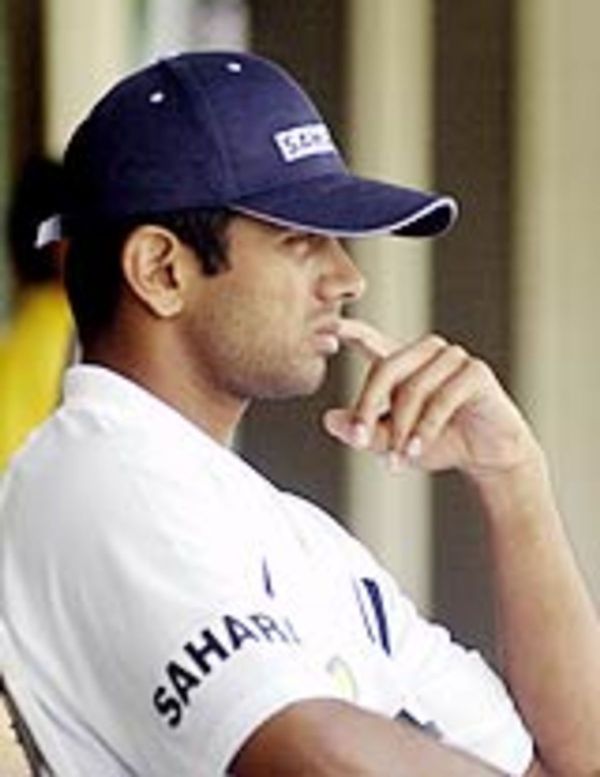
Rahul Dravid watched a match from a pavilion as a captain on 19 October 2003 in a second Test match against New Zealand
Then came the TVS Triangular series where Australia was participating as the third team along with India and New Zealand. India lost to Australia in the finals. Dravid scored two fifties in the series. The highlight of those fifties was one that came against New Zealand off 22 balls.
In the second match of the four-match Test series against Australia in their homeland, India was struggling with 85 runs for four wickets when Dravid along with Laxman added 303 runs for the fifth wickets after batting for 93.5 overs. Dravid scored 233 runs. In the fourth inning, India was given a target of 230 runs to win the match. Dravid helped India to chase the target by scoring an unbeaten fifty and was adjudged the ‘Player of the Match.’ After that match, captain Sourav Ganguly said,
“Rahul batted like God.”
He scored 619 runs in four Test matches at an average of 123.80. In the VB Series, he scored three fifties and each of those fifties came on a winning side. In the tour of Pakistan in March 2004, India participated in a five-match ODI series where Dravid scored 248 runs at an average of 62.00 and a strike rate of 73.59. Dravid scored 99 runs in the first match before getting bowled by Shoaib Akhtar which helped India to give Pakistan a target of 350 runs.
In the fourth ODI when India was trailing by 2-1, his fifty helped India to level the series.
Captaincy
Under Dravid’s leadership, India won their first-ever Test match in Pakistan in 2004. In the third test at Rawalpindi, he scored his highest test score of 270 runs before getting out by their part-time spin bowler Imran Farhat.
India went on to win the series for the first time in Pakistan under his leadership.
It was also India’s first Test series victory outside India since 1993. He was then appointed as the captain of India for the 2007 ODI World Cup which ended on a losing side. Then came India’s tour of England which India lost by 0-4. In the first Test at Lord’s, England gave India a target of 475 runs to win. In reply, Dravid scored 103 runs and became the eighth Indian batter to have a century at Lord’s. However, India was bowled out for 286 runs and lost the Test match.
The second Test took place at Trentbridge, Nottingham where Dravid was sent as an opening batter in place of injured Gambhir. He then scored another century i.e., 117 runs which again came on a losing side. However, he failed to score runs in the third Test and India lost the match by an inning and 242 runs. In the fourth Test at Oval, he again opened the batting and scored 146 runs off India’s total of 300 which India lost. In all, he has scored 461 runs in four games at an average of 76.83.
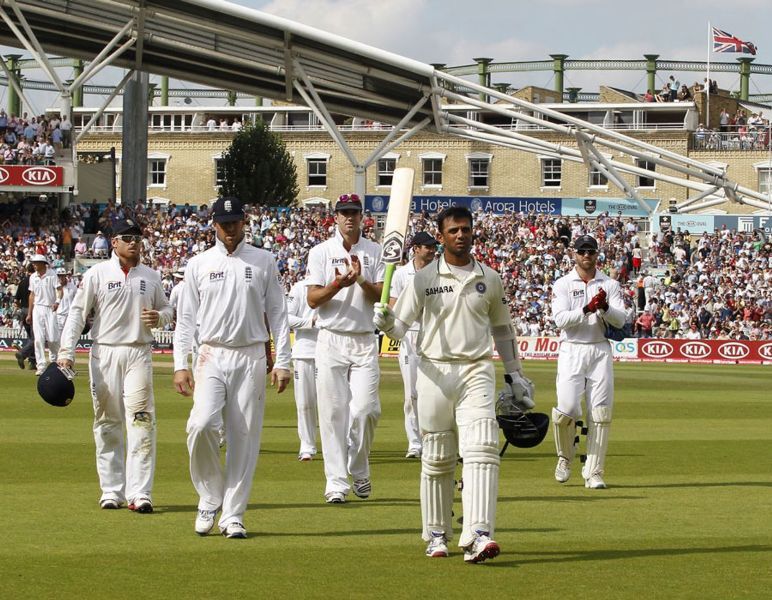
Rahul Dravid walking back to a pavilion after scoring fighting 146 runs against England on 21 August 2011
Retirement
He was dropped from an Indian side for the tour of England in 2009 and was again picked for the ODI series in England in 2011. Dravid didn’t expect this call. After being selected, he announced his retirement from ODI cricket after the series. His last ODI inning was against England at Sophia Gardens, Cardiff in September 2011 where he scored 69 off 79 balls before getting bowled by their spinner Graeme Swann.
Interestingly, in the same tour, he announced his retirement from T20I as well after playing just one T20I of his career against the same opponent. He announced his retirement from Test and first-class on 9 March 2012 after the 2011-12 tour of Australia. However, he would captain the Rajasthan Royals team in the Indian Premier League. In his retirement speech, he said, [40]India Today
“My approach to cricket has been reasonably simple: it was about giving everything to the team, it was about playing with dignity, and it was about upholding the spirit of the game. I hope I have done some of that. I have failed at times, but I have never stopped trying. It is why I leave with sadness but also with pride.”
In July 2014, he played for the MCC side in the Bicentenary Celebration match at Lord’s. In the same year, he retired from IPL cricket as well.
Post-retirement
Post-retiring, he took the role of the mentor of the Rajasthan Royals team.
During this time, he also became the mentor for the team’s tour of England in 2014. In 2015, he was appointed as the head coach of the India U-19 and India A teams. Under his coaching, India U-19s reached the finals of the u-19s Cricket World Cup in 2016. Two years later, India won the U-19s Cricket World Cup 2018 after beating Australia by 8 wickets. He then took the role of mentor of the Delhi Daredevils IPL team.
In July 2019, after his stint as the coach of the U-19 team, he became the head of National Cricket Academy (NCA) Bengaluru. In November 2021, he was appointed as the head coach of the Indian National Team.
Indian Premier League (IPL)
In IPL, Dravid played for Royal Challengers Bangalore (RCB) in 2008, 2009, and 2010. Then he played for Rajasthan Royals and took the team to the finals of Champions League 2013. After playing the Champions League, he announced his retirement from T20 cricket as well in September 2013.
Controversies
Ball Tempering Incident
On 20 January 2004, during a match at Gabba in Brisbane (Australia) in an ODI match against Zimbabwe, Rahul Dravid was caught on camera rubbing cough lozenge on the shinier side of the white ball while fielding. He was being reported by the third umpire Peter Parker to the match referee Clive Lloyd who said that Dravid had intentionally rubbed the lozenge to the ball. He was subsequently charged under clause 2.10 of the ICC’s code of conduct and was fined 50 percent of his match fees. However, the field umpires didn’t press any charge against him. [41]Hindustan Times
Greg Chappell Controversy
The quarrel between Sourav Ganguly and former Indian coach Greg Chappell is well documented in the history of cricket. As Sourav Ganguly made a comeback into the Indian side after that controversy, Rahul Dravid was the captain of the Indian team. All was not well in the dressing room. In one of the viral videos, Ganguly was seen arguing with Rahul Dravid in the presence of Greg Chappell. Moreover, Ganguly accused Dravid that he didn’t have the courage to revolt against Chappell. In an interview, he said, [42]Crictracker.com
“Because of Greg Chappell, the dressing room was divided. Rahul Dravid is the type of person who wants everything to go smoothly. He knew that things were going wrong, but he had no courage to revolt and tell him (Chappell) that he was doing wrong.”
If @robelinda2 doesn't get you then @desi_robelinda must 😂🙏 https://t.co/J700pKQkf7 pic.twitter.com/kZ0B4sxKrE
— Mainak Sinha🏏📽️ (@cric_archivist) March 29, 2020
Rahul Dravid’s declaration when Sachin was playing on 194
This controversy took place in 2004 in Multan during a test match against Pakistan when Virender Sehwag scored 309 runs. India was 675 for 5 when Sachin was batting on 194. The sixth wicket felt in a form of Yuvraj Singh. Dravid the stand-in skipper, then declared the Indian inning knowing that Sachin was one shot away from his double hundred. Sachin without uttering anything started walking back to the dressing room. This created the fallout between the two legends of Indian cricket. However, Sachin later clarified in his autobiography that the controversy didn’t impact their friendship. [43]Indian Express Limited
Awards, Honours, Achievements
- Arjuna Award by the Government of India in 1998
- CEAT International Cricketer of the World Cup in 1999
- Wisden Cricketer of the year in 2000
- Padma Shri by the Government of India in 2004
- ICC Award for the Test player of the year in 2004
- ICC Cricketer of The Year in 2004
- MTV Youth of the Year in 2004
- Sir Garfield Sobers Trophy in 2004
- Sexiest Sportsperson in the year 2004
- Captain of the ICC’s Test team in 2006
- NDTV Indian of the Year’s Lifetime Achievement Award with Dev Anand in 2011
- Don Bradman Award with Glenn Mcgrath in 2012
- Padma Bhushan by the Government of India in 2013
- Wisden India’s Highest-Impact Test Batter in 2015
- Inducted in the ICC Hall of Fame in 2018
Favorites
- Cricketers: Gundappa Viswanath, Michael Holding, Brian Lara, Sachin Tendulkar, Sunil Gavaskar
- His Inning: 81 at Jamaica against West Indies in a Test match on 30 June 2006
- Cricket Grounds: Eden Gardens (Kolkata) and Lord’s Cricket Ground
- Batting Shots: Square-Cut and Cover Drive
- Sports: Hockey, Football, and Badminton
- Sportsperson: Roger Federer
- Book: ‘Tough times never last, tough people do’ by Robert Schuller and Jonathan Livingston Seagull by Richard Bach
- Food: Chicken Tikka Masala, Mango Milkshake, Dal & rice, and Chocolates
- Singers: Bob Dylan and Bruce Springsteen
- Colour: Blue
- Actor: Tom Cruise and Aamir Khan
- Actress: Demi Moore and Michelle Pfeiffer
- Films: Braveheart and Ghost
Car Collection
Rahul Dravid own cars like Audi Q5, Hyundai Tuscon, Toyota Innova Crysta, Mercedes Benz GLE 350, and Porsche 911 Carrera S.
Salary
Dravid earns Rs. 10 Crore per annum as an Indian coach. [44]The Times of India
Net Worth
Rahul Dravid’s estimated net worth is Rs. 172 Crore ($23 Million) (as in 2021). [45]Crictracker.com
Facts/Trivia
- During an interview, he told that winning the Cottonian Shield inter-school cricket tournament is the biggest moment of his school life.
- Talking about the Ranji Trophy, he told,
“Ranji Trophy is a hard school. You are always under pressure because you know that there are so many people playing for just two or three spots on the Indian team. The Ranji Trophy is a perfect finishing school for me. It taught me so much, both on and off the field, both technically and mentally.”
- Besides playing for the Indian team, Rahul Dravid also played for the Scotland team in 11 matches. It so happened that in 2003, after the World Cup, many senior Indian players were given rest. At that time, Gwynne Jones, the Chief Executive of the Scottish Cricket Union approached the then head coach of the Indian national team John Wright and requested him to release any one of their players to play for the Scottish team. Gwynne Jones wanted Sachin Tendulkar to join their team but John Wright suggested Rahul Dravid’s name. He said,
“The person who is really going to do things for you, on and off the pitch, is Rahul Dravid.”
Dravid accepted the offer and scored 600 runs at an average of 66.66 in eleven games. While talking about his stint with the Scotland team, Dravid said,
“I enjoyed the friendships with players, officials, something I maintain till today. For both me and my wife it was a special three months to get the love and warmth of the people of Scotland. I would have loved the game to have been at the Grains, though,” Dravid had said in 2007.”
- Renowned cricket journalist, Christopher Martin-Jenkins once said about Dravid,
“If a Martian were to land on Earth now and be told that the best batsman in the world was playing in this match, he would think it was Rahul Dravid and not Sachin Tendulkar.”
- In MTV’s popular show – ‘Bakra’, Dravid was proposed by film actress Sayali Bhagat for marriage as a part of the prank. But he advised Sayali to rather focus on her education and devote her time to other important things in life.
- One of his habits was to tap the bats and practice in front of the mirror. His roommates were very cooperative and allowed him to prepare for the game at late night.
- His hobbies are reading books, listening to music, and spending time with his friends and family.
- There is a cricket tournament in Bengaluru whose name is derived from veteran cricketer Rahul Dravid. The name of this tournament is the ‘Jammy Cup’ and the player of the match gets the title of ‘Jammy of the day.’
- Some of the popular nicknames which Rahul Dravid earned are The Wall, Mr. Dependable, Mr. Cool, Jammy, The Gentleman of the Gentleman’s Game, etc.
- In an interview, Dravid revealed the reason behind his jersey number 19. He told that
“It’s easy to remember my wife’s birthday.”
- After India’s early exit from the 2007 Cricket World Cup after losing to Bangladesh, Dravid gifted his bat to the heroes of the match Mushfiqur Rahim and Tamim Iqbal. [46]Crictracker.com
- There are two biographies in the name of Rahul Dravid. One is ‘Rahul Dravid written by Vedam Jaishankar’ and another one is ‘Nice Guy Who Finished First written by Devendra Prabhudesai.’ [47]Crictracker.com
- Dravid is known for his cool and calm approach. But at times, he also lost his tempo. In 2004, during the Pakistan tour, captain Dravid was asked about the match-fixing at a press conference. Furious Dravid replied,
“Someone get this guy out of the room. It s ridiculous. These sorts of statements are just bad for the game.”
On another occasion, Dravid threw a chair in the dressing room after India lost against England in Mumbai in 2006. [48]Cricket Country
- Rahul Dravid is considered the first non-Australian cricketer who delivered the Bradman Oration in Canberra. [49]Mid-Day
- Dravid’s highest score of 270 runs against Pakistan in Rawalpindi is the longest innings played by an Indian batter in terms of minutes. (740 minutes).
- Rahul Dravid is a brand ambassador of some of the reputed brands in India like Plaeto, Piramal Realty, Practo, Aptech, InCred, Bengaluru FC, Manipal Hospitals, Arena Animation, CarDekho, etc. He is also endorsed by some of the brands in his career. These brands are Reebok, Pepsi, Kissan, Bank of Baroda, Max Life, Hutch, Sansui, Samsung, Gillette, etc.
- Rahul is often praised for his selfless attitude. While talking about him, in an interview, Pakistani cricketer Shoaib Malik recalled an incident. He shared that while he was travelling from Pakistan to New Zealand with his team, the Indian under-19 cricket team, coached by Rahul, was also on the same flight. According to Shoaib, Rahul had a strong desire to engage in a conversation with him to learn about his experiences in making comebacks in the cricket profession and the motivations that drove him. As Shoaib was asleep, Rahul waited for two hours to have this discussion. [50]The Times of India Shoaib Malik added,
So what I am trying to say through this is that he has no ego. He wanted to learn what you go through (while trying to make a comeback). In his own career he has seen lots of ups and downs. So he asked me and I told him. I liked that a lot. The learning process never ends and look where the Indian team is standing today (under Rahul Dravid)”
References

